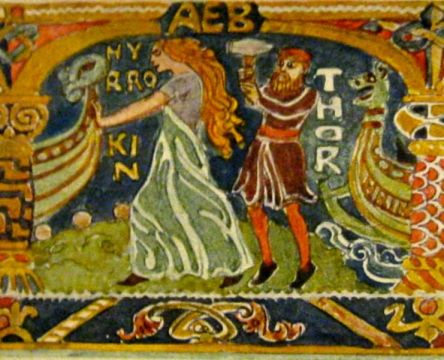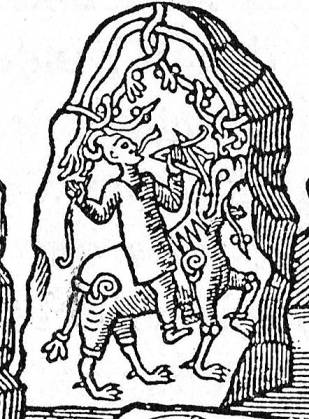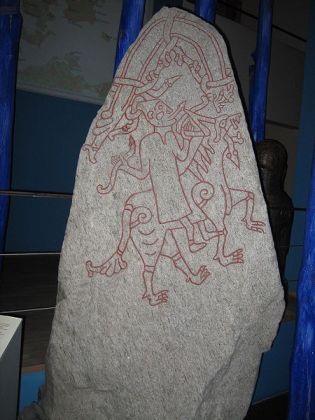In Norse mythology, Hyrrokkin is a jötun giantess known for her incredible strength and dark, shriveled appearance. While not much is known about her, there are some interesting possibilities that some people have speculated about.
The story of Hyrrokkin begins at the funeral of Baldur. At the funeral, Baldur’s wife Nanna died of grief and was placed alongside him on his pyre. The gods then attempted to launch Baldur’s ship, Hringhorni, into the sea to serve as his funeral ship. However, despite their best efforts, they were unable to move the ship.
As a result, the gods decided to enlist the help of Hyrrokkin, who lived in Jötunheimr, the land of giants. Hyrrokkin arrived on a giant wolf, which she controlled using serpents as reins. When she dismounted, Odin summoned four berserkers to look after the animal but they were unable to control it without first rendering it unconscious.
With her seismic strength, Hyrrokkin was able to roll the ship into the water with just one push. It caused the earth to quake and the rollers under the ship to set on fire. This angered Thor, who was about to kill Hyrrokkin with his hammer Mjöllnir, but the other gods insisted that he spare her.

In this way, Hyrrokkin helped the gods to launch Baldur’s ship into the sea, allowing him to be sent off on his final journey. Her incredible strength was unmatched by anyone in Asgard, and she proved to be an essential figure in the funeral rites of the gods.
Speculations on her Origins
As I already mentioned, Hyrrokkin is fairly unknown and doesn’t play any parts in other stories. At least not that we know of. However, one theory I came across several times when researching this post I found interesting.
The theory is that she might be the same giantess mentioned as living in the forest Járnvidr. If so, she is the mate of Fenrir and would be a mother to Sköll and Hati. They are the two wolves forever chasing the moon and sun until Hati one day catches the sun, devouring it. That then is the start of the Fimbulwinter, and ultimately Ragnarok.
This actually makes some sense, at least to me personally. That the mother of Sköll and Hati should be completely unknown to the Vikings seems highly improbable. They figured in prominent places in their association with both the sun and moon as well as Ragnarok. Their father is none other than Fenrir so the mother should at least be known.
That Hyrrokkin comes riding to Asgard on a large and wild wolf speaks to her being closely associated with wolves. No less than four berserkers tried to hold the wolf, but they had to knock it unconscious to do so.
The fact is that we will likely never know for sure if Hyrrokkin played a larger part in the mythos. It could be that all she ever did was push Baldur’s ship, and then get killed for her troubles. Or, possibly she was well known to the Aesir. In such a case, as the mother of Sköll and Hati and for her relationship with Fenrir.
Mentions and Depictions of Hyrrokkin

From the Gylfaginning
Towards the end of Gylfaginning, Balder’s death and a funeral pyre is described.
“The Aesir took the corpse of Balder and brought it to the sea-shore. Hringhorn was the name of Balder’s ship, and it was the largest of all ships. The gods wanted to launch it and make Balder’s bale-fire thereon, but they could not move it. Then they sent to Jotunheim after the giantess whose name is Hyrrokkin.
She came riding on a wolf, and had twisted serpents for reins. When she alighted, Odin appointed four berserks to take care of her steed, but they were unable to hold him except by throwing him down on the ground. Hyrrokkin went to the prow and launched the ship with one single push, but the motion was so violent that fire sprang from the underlaid rollers and all the earth shook. Then Thor became wroth, grasped his hammer, and would forthwith have crushed her skull, had not all the gods asked peace for her.”
Play Jötunn Quiz
Do you want to learn more about the magical and powerful Jötunn? Then test your knowledge with this fun quiz game!
Don’t forget to play our other games as well!
Skaldskaparmal
In the Skaldskaparmal, Snorri included poems with lists of various kennings (other names/metaphors) for the gods and other things. Naturally, Thor has quite a few kennings. I am omitting most of these, but including the skaldic song where Hyrrokkin is mentioned. Here though, Thor did apparently not spare her life, but killed her along with a number of other jotnar.
The poem by Thorbjörn Disarskáld is believed to have been written the late 10th century.
IV. “What figures should be employed to paraphrase the name of Thor?
Here he is called Giant of Vimur’s Ford. There is a river called Vimur, which Thor waded when he journeyed to the garth of Geirrödr.
Thus sang Thorbjörn Disarskáld:
Thou didst smite the head of Keila,
Smash Kjallandi altogether,
Ere thou slewest Lútr and Leidi,
Didst spill the blood of Búseyra;
Didst hold back Hengjankjapta,
Hyrrokkin died before;
Yet sooner in like fashion
Svívör from life was taken.
Mentions in lists by anonymous skalds
Hyrrokkin is also mentioned in a list of female jötuns made by an anonymous poet. This is also believed to have been written in the 10th century. This list “Trollkvenna heiti” is part of a collection lists of names and “kennings” for a number of different gods, other beings and things:
“I shall enumerate the names of troll-women: Gríðr and Gnissa, Grýla, Brýja, Glumra, Geitla, Gríma and Bakrauf, Guma, Gestilja, Grottintanna.
Gjálp, Hyrrokkin, Hengikepta, Gneip and Gnepja, Geysa, ogress, Hǫrn and Hrúga, Harðgreip, Forað, Hrygða, Hveðra and Hǫlgabrúðr.”
Depiction on a Rune Picture Stone
She is depicted on one of the surviving stones from the Hunnestad Monument near Marsvinsholm, Sweden called DR 284.

As you can see in this image she is riding on her large wolf. Both the reins and her tongue seem to be serpents, and she is holding one in her hand as well.
Featured Image Credit: Ludwig Pietsch, Public domain, via Wikimedia Commons
